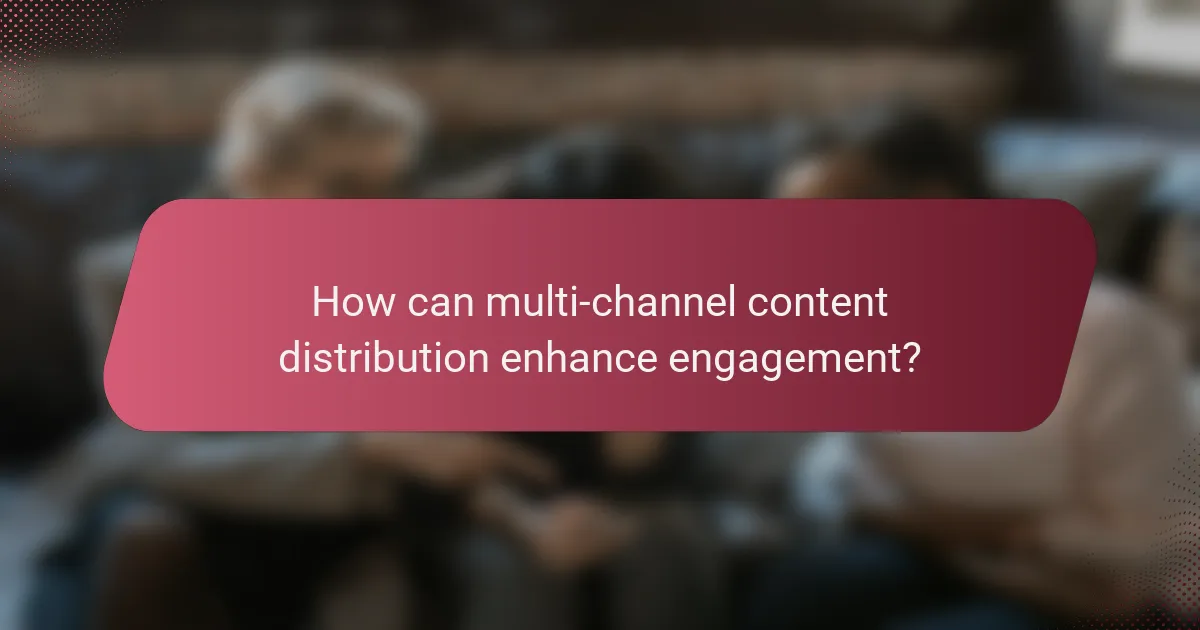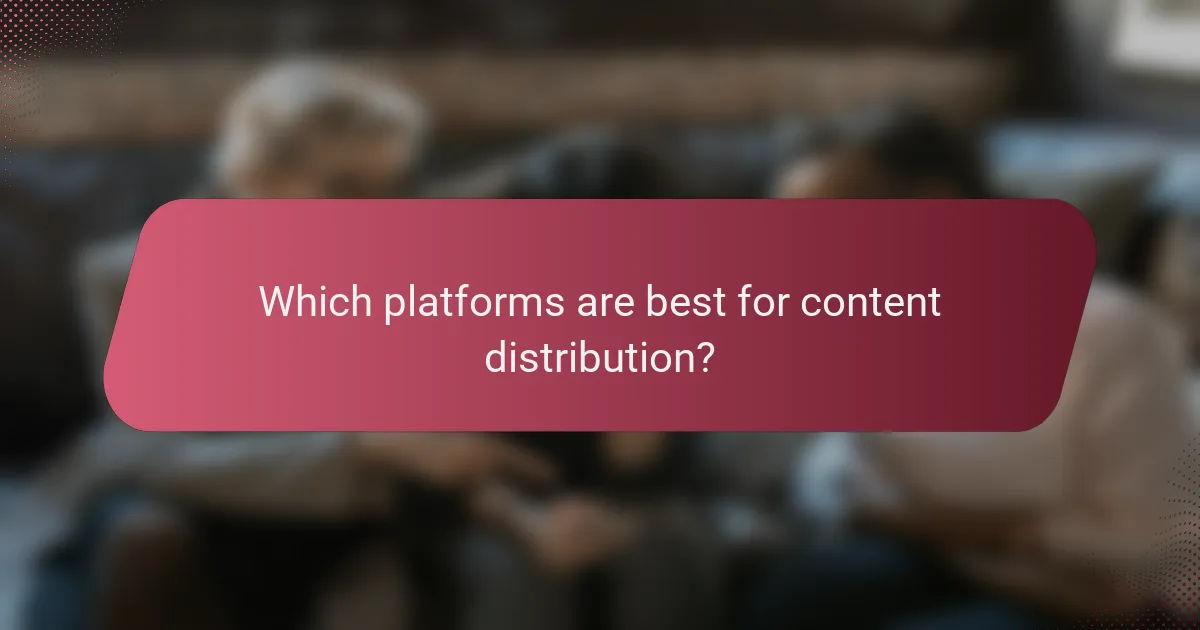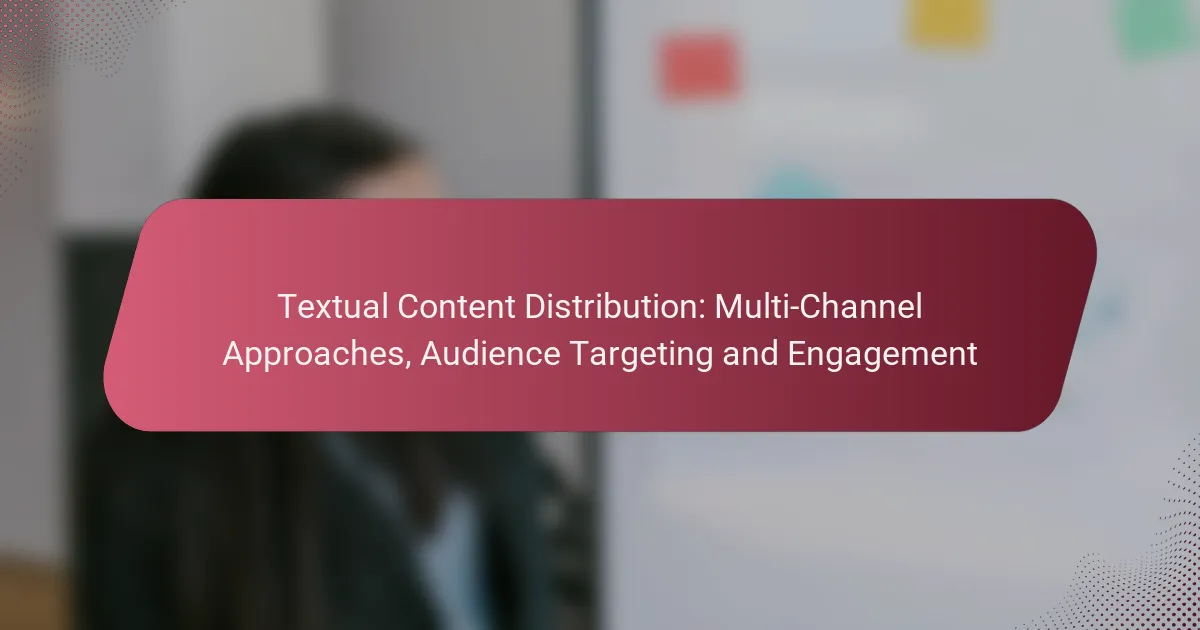In today’s digital landscape, multi-channel content distribution is essential for brands aiming to engage their audiences effectively. By connecting with users across various platforms, businesses can enhance interaction opportunities and foster deeper connections. Tailoring content through effective audience targeting strategies further improves engagement and conversion rates, ensuring that messaging resonates with specific demographic groups.

How can multi-channel content distribution enhance engagement?
Multi-channel content distribution enhances engagement by allowing brands to connect with their audience across various platforms, increasing interaction opportunities. This approach ensures that content reaches users where they are most active, fostering deeper connections and driving engagement.
Increased audience reach
Utilizing multiple channels broadens the potential audience significantly. By distributing content on social media, email, websites, and other platforms, brands can tap into diverse demographics and interests. For instance, a campaign targeting millennials might focus on Instagram and TikTok, while a B2B initiative may prioritize LinkedIn and email newsletters.
To maximize reach, consider tailoring content for each channel. Short, engaging videos may perform well on social media, while in-depth articles are better suited for blogs or newsletters. This strategic approach ensures that content resonates with the specific audience of each platform.
Improved brand visibility
Multi-channel distribution enhances brand visibility by consistently presenting content across various touchpoints. When users encounter a brand multiple times in different contexts, it reinforces recognition and familiarity. This can lead to increased trust and loyalty, as consumers are more likely to engage with brands they recognize.
To improve visibility, maintain a cohesive brand message and visual identity across all channels. Regularly updating content and engaging with audiences can also keep the brand top-of-mind. For example, sharing user-generated content on social media can further enhance visibility while fostering community engagement.
Higher conversion rates
Engaging users through multiple channels can lead to higher conversion rates as it provides various opportunities for users to take action. When potential customers encounter tailored content that speaks to their needs across different platforms, they are more likely to convert, whether that means making a purchase, signing up for a newsletter, or following the brand on social media.
To boost conversion rates, implement clear calls-to-action (CTAs) tailored to each channel. For instance, a compelling CTA on a social media post may encourage users to visit a website, while an email might prompt a direct purchase. Regularly analyzing performance metrics can help refine strategies and improve overall conversion rates.

What are effective audience targeting strategies in the US?
Effective audience targeting strategies in the US involve understanding and segmenting your audience based on various criteria to enhance engagement and conversion rates. By leveraging demographic, behavioral, and geographic targeting, businesses can tailor their messaging to resonate with specific groups, improving overall marketing effectiveness.
Demographic segmentation
Demographic segmentation divides the audience based on characteristics such as age, gender, income, education, and family size. This method allows marketers to create targeted campaigns that appeal to specific demographic groups, such as millennials or high-income households. For instance, a luxury brand may focus its advertising efforts on individuals aged 30-50 with a higher disposable income.
When implementing demographic segmentation, consider using data analytics tools to gather insights about your audience. This can help identify which segments are most likely to respond to your offerings. However, avoid making assumptions based solely on demographics; always validate with actual engagement data.
Behavioral targeting
Behavioral targeting focuses on the actions and behaviors of users, such as their browsing history, purchase patterns, and engagement with previous campaigns. By analyzing these behaviors, marketers can deliver personalized content that aligns with users’ interests and needs. For example, if a user frequently visits travel websites, targeted ads for vacation packages may be effective.
To effectively implement behavioral targeting, utilize tracking tools and analytics to monitor user interactions. Create segments based on behaviors, such as frequent buyers or cart abandoners, and tailor your messaging accordingly. Be cautious of privacy regulations and ensure compliance with laws like the CCPA when collecting and using behavioral data.
Geographic targeting
Geographic targeting involves segmenting audiences based on their physical location, allowing businesses to tailor their marketing efforts to specific regions or localities. This strategy is particularly useful for businesses with location-based services or products. For example, a restaurant chain may promote different menu items based on regional preferences.
When using geographic targeting, consider factors such as local culture, climate, and economic conditions that may influence consumer behavior. Tools like geofencing can help deliver location-specific ads to users’ mobile devices. Always ensure that your messaging is relevant to the local audience to maximize engagement and conversion rates.

Which platforms are best for content distribution?
The best platforms for content distribution depend on your target audience and content type. Social media, email marketing, and content syndication networks each offer unique advantages for reaching and engaging different demographics.
Social media platforms
Social media platforms like Facebook, Twitter, Instagram, and LinkedIn are effective for distributing content due to their vast user bases and targeting capabilities. Each platform caters to different demographics, so it’s crucial to choose the right one based on your audience’s preferences.
When using social media for content distribution, consider the format that works best for each platform. For example, visual content performs well on Instagram, while LinkedIn is ideal for professional articles and industry insights. Regularly analyze engagement metrics to refine your strategy.
Email marketing
Email marketing remains a powerful tool for content distribution, allowing for direct communication with your audience. Building a quality email list is essential; focus on collecting emails through sign-up forms and lead magnets to ensure you reach interested recipients.
Segment your email list based on user preferences or behaviors to enhance engagement. Personalization can significantly improve open and click-through rates. Aim for concise, compelling subject lines and clear calls to action to drive traffic to your content.
Content syndication networks
Content syndication networks, such as Outbrain and Taboola, help distribute your articles across various websites, increasing visibility and reach. These platforms place your content on high-traffic sites, allowing you to tap into new audiences who may not be familiar with your brand.
When using syndication networks, ensure your content is high-quality and relevant to the audience of the sites where it will appear. Monitor performance metrics to assess the effectiveness of your syndication efforts and adjust your strategies accordingly for better results.

What metrics should be tracked for content distribution success?
To measure content distribution success, focus on key metrics such as engagement rates, traffic sources, and conversion rates. These metrics provide insights into how well your content resonates with the audience and drives desired actions.
Engagement rates
Engagement rates indicate how actively your audience interacts with your content. This includes metrics like likes, shares, comments, and time spent on the page. A higher engagement rate often signals that your content is relevant and appealing to your target audience.
To improve engagement, consider using compelling visuals, asking questions, or encouraging user-generated content. Aim for engagement rates that are in the range of 1-5% for social media platforms, while website content may target a time-on-page of over 2 minutes.
Traffic sources
Traffic sources reveal where your audience is coming from, whether it’s organic search, social media, email campaigns, or referrals. Understanding these sources helps identify which channels are most effective for distributing your content.
Utilize tools like Google Analytics to track traffic sources and assess their performance. Focus on optimizing high-performing channels while experimenting with new ones. A balanced approach can lead to a diverse traffic mix, ideally with at least 30-50% coming from organic sources.
Conversion rates
Conversion rates measure the percentage of visitors who take a desired action, such as signing up for a newsletter or making a purchase. This metric is crucial for evaluating the effectiveness of your content in driving business goals.
To enhance conversion rates, ensure your calls-to-action (CTAs) are clear and compelling. Aiming for conversion rates between 2-5% is common, but this can vary significantly by industry and content type. Regularly test different CTAs and landing pages to find what works best for your audience.

What are the prerequisites for a successful content distribution strategy?
A successful content distribution strategy requires clear objectives and a deep understanding of the target audience. These elements ensure that content reaches the right people through the most effective channels, maximizing engagement and impact.
Clear content goals
Establishing clear content goals is essential for guiding your distribution efforts. Goals should be specific, measurable, achievable, relevant, and time-bound (SMART). For instance, aiming to increase website traffic by 20% over six months can help focus your strategy.
Consider what you want to achieve with your content, whether it’s brand awareness, lead generation, or customer retention. Align your distribution channels with these goals to ensure your efforts are effective and targeted.
Understanding target audience
A comprehensive understanding of your target audience is crucial for effective content distribution. This includes demographics, interests, behaviors, and preferred platforms. Conducting surveys or using analytics tools can provide valuable insights into your audience’s preferences.
Segmenting your audience based on these characteristics allows for tailored messaging and channel selection. For example, younger audiences may prefer social media platforms like Instagram or TikTok, while professionals might engage more on LinkedIn. Knowing where to find your audience enhances the likelihood of successful engagement.
